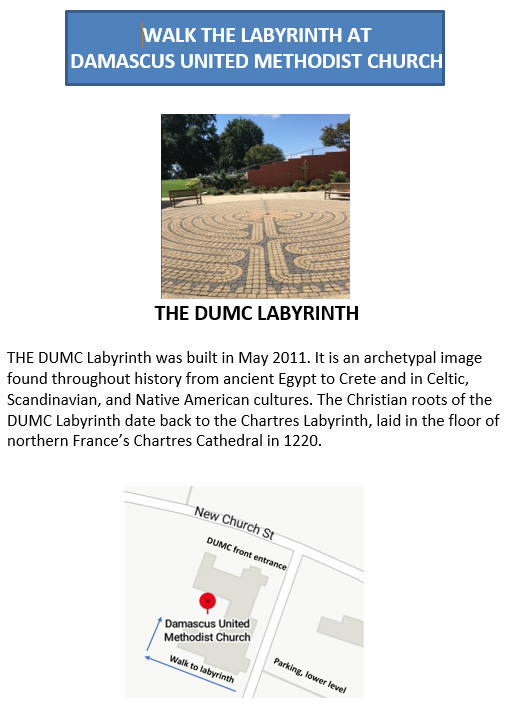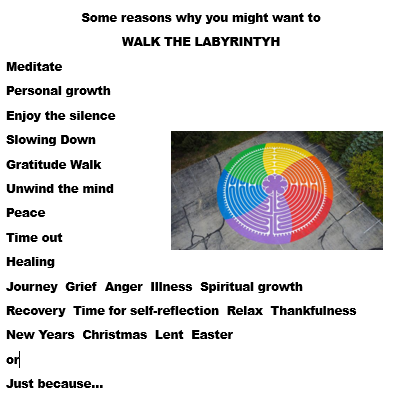What is a labyrinth?
The labyrinth is an ancient sacred symbol of pilgrimage to the Divine. Early Christians took a vow to visit the Holy City of Jerusalem at some point in their lives, but during the Middle Ages, travel was unsafe, and other means were needed to fulfill that sacred commitment. Labyrinths were adopted by the Roman Church to offer a way of fulfilling the sacred pilgrimage vow.
Unlike a maze, the labyrinth has only one path which leads to the center and out again. There are no tricks, dead ends, cul-de-sacs, or intersecting paths. There are no choices to be made, other than the primary one: the decision to enter the path. The path winds throughout and becomes a mirror for where we are in our own lives. Walking the path is a letting go of daily concerns and opening ourselves to God's healing presence in the center. The insights we receive are then taken back out the path into our lives.
Walking the labyrinth just naturally causes our attention to start turning inward, focusing in the present moment. Labyrinths can be used as a spiritual practice to help relieve stress, to help people work through grief, and also to provide comfort during illness. At the most basic level, walking the labyrinth focuses the attention, stills the mind, and quiets the breathing.
-
• Take time before you begin to disengage from your day and relax. Consider the issues, concerns, questions, or dreams you want to take with you on this walk. Or, simply decide to clear and quiet your mind and put yourself in a receptive state.
• Maintain silence throughout your walk for your own and other's reflection.
• Move at your own pace. Feel free to pause at any place. You may pass others who are moving at a slower rate. The path is two ways: those going in will pass those coming out.
• Upon reaching the center, you may sit, kneel, stand, meditate, face several directions, pray, or read something you brought along with you. Stay in the center as long as you wish.
• Walking out of the labyrinth is a time for integration and gratitude for the gifts received.
-
There are three stages ofthe walk:
The 'inward' journey, as you enter the labyrinth: The theme of the inward journey is letting go of things which hold back our wholeness and inner approach to God.
The 'center' : The center of the labyrinth is a space of meditative prayer and peace.
The 'outward' journey, as you exit the path: The theme of the outward' journey is relationship - with ourselves, with others and with the earth - seen in the light of our relationship with God.
-
Walk with Openness: Lord, what do you want me to know? What do you want to show me? Speak, Lord, your servant is listening.
Walk as Intercessory Prayer: Lord, may I tell you about this person, situation, need? Lord, I place in your tender care ...
Walk to honor a significant date or transition: Lord, it was just a year ago that ... Lord, thank you that I have this new opportunity to...
Walk using a prayer phrase: Repeat one of God's names that has deep meaning for you (Abba, Savior, The Great I Am), repeat a spiritual word that has significance for you (Peace, Hope, Trust, Love), or repeat a short phrase (Your will be done; Jesus, Remember me).
Walk to reflect: Think about something in particular that is concerning you right now.
Walk to observe: Lord, help me pay attention to what I see, what I feel, everything I sense during this walk. What do I see? What do I hear? Where are you, Lord, in all of this?
Walk to let go: Lord, what do you invite me to release into your care? Walk with a question: Lord, what is my next step?
From our Sacred Path labyrinth ministry: You are invited to walk the church labyrinth using the prayer below. Please use this prayer as you are inspired, whether you walk the labyrinth or not.
Prayer for Hope Today
Lord, help me to hear you saying, “I am your hope” over all the other voices.
Lord, your word says you are hope for the hopeless, so I’m running to you with both hands outstretched and grabbing on to you. Fill me up with hope and give me a tangible reminder today that hope is an unbreakable spiritual lifeline (Hebrews 6:19-20).
God, you know those things in my heart that I barely dare to hope for.
Today I give them to you, I trust them to you, and ask them of you, because I know that you can do more than I could ever guess, imagine, or request in my wildest dreams (Eph 3:20).
God, you are my hope and I trust you. Amen.
(Author unknown)








